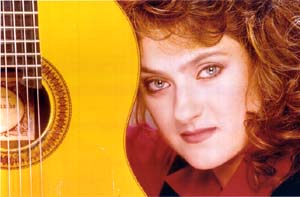
|
An interview with...
|
 Marija is a multi-talented flamenco artist who not only plays guitar, she also sings and dances!
Marija is a multi-talented flamenco artist who not only plays guitar, she also sings and dances!Her unique perspective in this art form and her desire to teach has helped many dance, guitar and cante students get past the common miscommunication problems so they can focus on the art of flamenco. Her Flamenco Communication workshop has been featured at the University of New Mexico International Flamenco Festival and around the USA. Let's take a peek into Marija's mind, shall we? What general advice would you give to guitarists playing for beginning dancers?When accompanying a beginning dance class, play very straightforward compás. Beginning dance students are thinking about many things at the same time. They’re learning arm movements and how to coordinate them with footwork. Some of them will even tune you out. Be very patient. You’ll have a chance to try the fancy stuff later once the dancers have learned the basics.
OK...how about some general advice for beginning dancers.
The guitarists are intently watching the dancers' arm movements and listening to the rhythm of their footwork.
It’s beyond just emoting steps, we need to know how to communicate and improvise and inspire one another because of what we do, where we put it and WHY. We’re taking people on a musical and emotional journey in flamenco. What’s the first thing a guitarist should learn to accompany singers?
You can’t do enough listening. The more you know about the structure of the cante, the more you can see how it all fits together. When you are accompanying the singer, do not change the chord just because it’s the next one in the usual progression. Change the chord because you hear the cante melody RESOLVING to that chord. For any given reason, patterns can and do change. For example a singer may take artistic license and surprise the listener by not giving what he is expecting to hear—-in effect taking the listener on a musical "detour."
Editor's note: Want more? Stay tuned. In the future, I'll be publishing more excerpts from this interview. For now, visit her website at http://marijatemo.com/ If you would like write to Marija, her email is marijatemo@juno.com (Photo by Ken Ross. Permission to republish here courtesy of Marija Temo) |